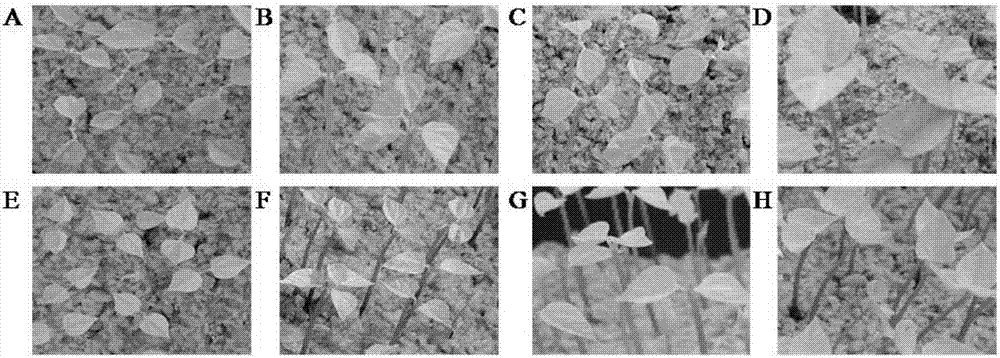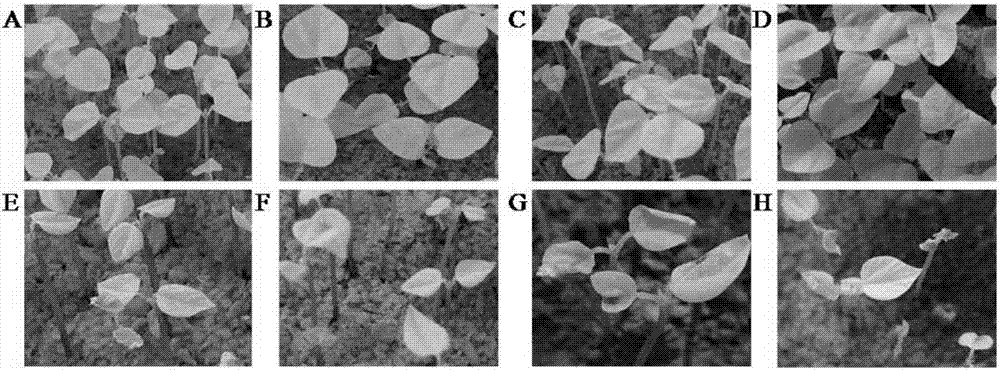Method for identification and evaluation of cold resistance of red beans
A technology for adzuki bean and cold resistance, which is applied in the field of identification and evaluation of the cold resistance of adzuki bean, and can solve the problems of nutrient depletion, withering, and abnormal leaf photosynthesis.
- Summary
- Abstract
- Description
- Claims
- Application Information
AI Technical Summary
Problems solved by technology
Method used
Image
Examples
Embodiment 1
[0035] Embodiment 1, by H 2 o 2 Identification of Cold Resistance of Adzuki Bean by Content Change
[0036] 1. The processing method of red bean
[0037] The most representative cold-resistant varieties at emergence in Hokkaido, Japan—Akagen Danagyan and the non-cold-resistant variety at emergence—Madara small grain line-1 were selected. The two varieties are respectively planted in a nutrient bowl, and vermiculite is packed into the nutrient bowl, and 30-40 red bean seeds are sown at intervals of 2 cm in each nutrient bowl, and are repeated three times. After sowing, place the seedlings at a constant temperature of 25°C and 100% darkness for emergence, and move to a light intensity of 700-1000 μmol / m after emergence. 2 / s, the red bean of each variety was divided into two groups, which were grown under low temperature conditions (10°C to 13°C day and night) for 18d and 28d respectively, and then each group was divided into three groups and moved to a natural light room at ...
Embodiment 2
[0048] Embodiment 2, identify the cold resistance of red bean by the change of chlorophyll content
[0049] 1. The processing method of red bean
[0050] Same as Step 1 of Example 1.
[0051] 2. Determination of chlorophyll content
[0052] Take the young leaves of the cold-resistant variety Akagen Danayan and the non-cold-resistant variety Banxiaoli-1, and measure the chlorophyll content of the leaves at the seedling stage of the greening treatment for 0h, 3h, 8h and 28h after the short-term low temperature treatment for 18 days and the long-term low temperature treatment for 28 days, respectively . The determination of chlorophyll content was carried out according to the method of Kato Rong (Photosynthesis Research Methods. Kyoritsu Publishing House, Tokyo, 1981, 40-41). Each treatment setting was replicated at least 3 times.
[0053] The measurement results are shown in Table 2.
[0054] Table 2 Chlorophyll content of red bean seedling stage leaves after greening treat...
Embodiment 3
[0061] Embodiment 3, the activity measurement of antioxidant enzyme
[0062] 1. The processing method of red bean
[0063] Same as Step 1 of Example 1.
[0064] 2. Determination of Antioxidant Enzyme Activity
[0065] Under stress conditions, free radicals produced in plants can cause degreasing and peroxidation of plasma membranes, destroying the structure and function of biofilms, and antioxidant enzymes in plants include superoxide dismutase (SOD), ascorbic acid peroxidation Catalase (APX) and catalase (CAT), etc., can eliminate the adverse effects of reactive oxygen species and peroxides to a certain extent, and maintain the stability of cell membranes.
[0066] SOD is a metalloenzyme commonly found in aerobic organisms. It cooperates with peroxidase and catalase to defend the cell membrane from active oxygen or other peroxide free radicals. SOD can catalyze the disproportionation of oxygen free radicals. The reaction produces hydrogen peroxide, which can be converted i...
PUM
 Login to View More
Login to View More Abstract
Description
Claims
Application Information
 Login to View More
Login to View More - R&D Engineer
- R&D Manager
- IP Professional
- Industry Leading Data Capabilities
- Powerful AI technology
- Patent DNA Extraction
Browse by: Latest US Patents, China's latest patents, Technical Efficacy Thesaurus, Application Domain, Technology Topic, Popular Technical Reports.
© 2024 PatSnap. All rights reserved.Legal|Privacy policy|Modern Slavery Act Transparency Statement|Sitemap|About US| Contact US: help@patsnap.com










